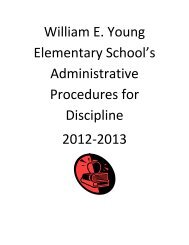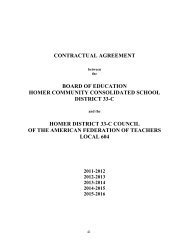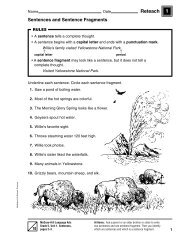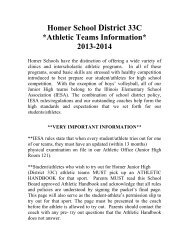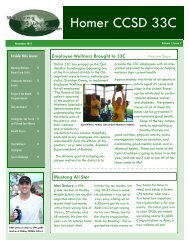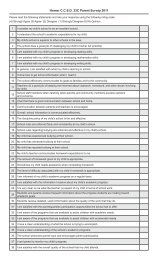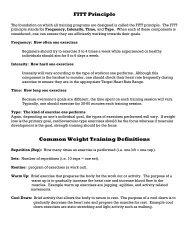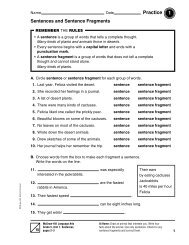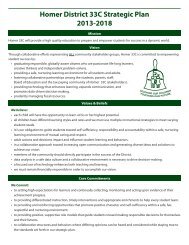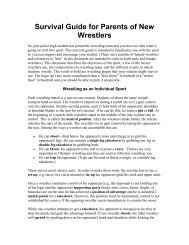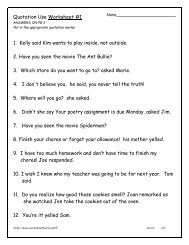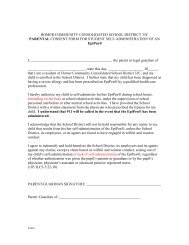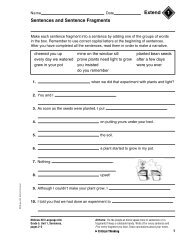Create successful ePaper yourself
Turn your PDF publications into a flip-book with our unique Google optimized e-Paper software.
Name _________________________________________________<br />
Extend Your <strong>Thinking</strong><br />
11-1<br />
Patterns in Numbers<br />
Write what comes next in each pattern. Then describe the<br />
rule (there may be more than one rule).<br />
1. 1, 4, 9, 16, 25, __________, __________, __________<br />
Rule: __________________________________________________________<br />
__________________________________________________________________________<br />
2. 0, 3, 8, 15, 24, __________, __________, __________<br />
Rule: __________________________________________________________<br />
__________________________________________________________________________<br />
3. 0, 2, 6, 12, 20, __________, __________, __________<br />
Rule: __________________________________________________________<br />
__________________________________________________________________________<br />
4. 2, 6, 12, 20, 30, __________, __________, __________<br />
Rule: __________________________________________________________<br />
__________________________________________________________________________<br />
5. 2, 4, 6, __________, __________, __________<br />
Rule: __________________________________________________________<br />
__________________________________________________________________________<br />
6. 81, 64, 49, 36, 25, 16, __________, __________, __________<br />
Rule: __________________________________________________________<br />
__________________________________________________________________________<br />
7. 78, 61, 46, 33, 22, __________, __________, __________<br />
Rule: __________________________________________________________<br />
__________________________________________________________________________<br />
Use with pages 488–489. 139<br />
© Scott Foresman Addison Wesley 5
Name _________________________________________________<br />
Extend Your <strong>Thinking</strong><br />
11-2<br />
Patterns in Algebra<br />
Complete each table. Write the rule for each.<br />
1. Rule: ____________________<br />
2. Rule: ____________________<br />
3. Rule: ____________________<br />
4. Rule: ____________________<br />
5. Rule: ____________________<br />
6. Rule: ____________________<br />
140 Use with pages 490–491.<br />
In 2 3 9 5 10 8<br />
Out 6 9 27<br />
In 25 15 40 55 5 60<br />
Out 5 3 8<br />
In 51 54 50 99 72 100<br />
Out 7 10 6<br />
In 1 4 18 7 15 90<br />
Out 13 16 30<br />
In 7 11 3 4 12 10<br />
Out 42 66 18<br />
In 48 64 40 96 800 88<br />
Out 6 8 5<br />
© Scott Foresman Addison Wesley 5
Name _________________________________________________<br />
Extend Your <strong>Thinking</strong><br />
11-3<br />
<strong>Critical</strong> <strong>Thinking</strong><br />
Trace and cut out the 25 pieces that make up the grid below.<br />
Rearrange the pieces in a 5-by-5 square so that no row,<br />
column, or diagonal will have more than one of the same<br />
figure. Record your solution using the names of the figures.<br />
Compare your solution with those of your classmates.<br />
Is there more than one solution?<br />
cube<br />
Use with pages 492–493. 141<br />
© Scott Foresman Addison Wesley 5
Name _________________________________________________<br />
Extend Your <strong>Thinking</strong><br />
11-4<br />
Decision Making<br />
Design an apartment using these guidelines. Draw your<br />
apartment on the grid below. Each square represents<br />
25 square feet.<br />
• Your apartment must have an area of 1,000 square feet<br />
or less.<br />
• You can have one to three bedrooms.<br />
• You must have a kitchen, a bathroom, and a living room.<br />
• You can have a separate dining room, or you can eat in<br />
your kitchen.<br />
142 Use with pages 494–495.<br />
© Scott Foresman Addison Wesley 5
Name _________________________________________________<br />
Extend Your <strong>Thinking</strong><br />
11-5<br />
Visual <strong>Thinking</strong><br />
Which box has the greatest surface area? Circle it.<br />
1.<br />
2.<br />
3.<br />
4.<br />
5.<br />
4 in.<br />
8 m<br />
8 in.<br />
6 m 3 m<br />
8 cm<br />
12 cm<br />
9 in.<br />
9 in.<br />
2 cm<br />
3.5 in. 2.5 in.<br />
11 ft<br />
7 ft<br />
6 m<br />
8 in. 7 in.<br />
5 in. 5 in.<br />
9 in. 9 in.<br />
4 m<br />
8 m 8 m<br />
4 m 3 m<br />
4 cm<br />
7 cm<br />
3 cm 12 cm 2 cm 12 cm<br />
6.5 ft<br />
8 in. 9 in.<br />
11 ft<br />
4 ft 4 ft<br />
4 in. 3.5 in.<br />
1.5 in. 2 in.<br />
9 ft<br />
8.2 ft<br />
7 ft<br />
Use with pages 496–497. 143<br />
© Scott Foresman Addison Wesley 5
Name _________________________________________________<br />
Extend Your <strong>Thinking</strong><br />
11-6<br />
<strong>Critical</strong> <strong>Thinking</strong><br />
Place the weights in order from least to greatest.<br />
1. 35 oz, 2 lb, 3 lb, 44 oz<br />
__________________________________________________________________________<br />
2. 8 T; 12,500 lb; 7.5 T; 16,200 lb<br />
__________________________________________________________________________<br />
3. 72 oz, 5 lb, 1 T, 455 oz<br />
__________________________________________________________________________<br />
4. 3,000 oz; 54 lb; 700 lb; 4.5 lb<br />
__________________________________________________________________________<br />
5. Describe the steps you took to order the weights.<br />
__________________________________________________________________________<br />
__________________________________________________________________________<br />
6. Can you order the following measurements from least to<br />
greatest? Explain.<br />
18 in., 2 ft, 3 oz, 5 yd, 16 lb<br />
__________________________________________________________________________<br />
__________________________________________________________________________<br />
144 Use with pages 500–501.<br />
© Scott Foresman Addison Wesley 5
Name _________________________________________________<br />
Extend Your <strong>Thinking</strong><br />
11-7<br />
Patterns in Numbers<br />
Find the pattern. Write the next three measurements.<br />
You can use a calculator to help.<br />
1. 10 oz, 1 lb, 1lb 6 oz, 1 lb 12 oz, __________, __________, __________<br />
2. 1 g, 10 g, 100 g, 1 kg, __________, __________, __________<br />
3. 20 g, 25 g, 30 g, 35 g, __________, __________, __________<br />
4. 0.25 kg, 0.5 kg, 0.75 kg, 1 kg, __________, __________, __________<br />
5. 10 kg, 5 kg, 2.5 kg, 1.25 kg, __________, __________, __________<br />
6. 2 oz, 4 oz, 8 oz, 1 lb, __________, __________, __________<br />
7. 500 lb; 1,000 lb; 1 T; 2 T; __________; __________; __________<br />
8. 5 T; 50 T; 500 T; 5,000 T; ____________; _____________; _____________<br />
9. 1 kg, 10 kg, 1 kg, 100 kg, __________, __________, __________<br />
10. 29 lb, 22 lb, 16 lb, 11 lb, __________, __________, __________<br />
Make up your own patterns using weights. Make<br />
some patterns using customary measures and others<br />
using metric measures.<br />
11. ________, ________, ________, ________, ________, ________<br />
12. ________, ________, ________, ________, ________, ________<br />
13. ________, ________, ________, ________, ________, ________<br />
14. ________, ________, ________, ________, ________, ________<br />
15. ________, ________, ________, ________, ________, ________<br />
Use with pages 502–503. 145<br />
© Scott Foresman Addison Wesley 5
Name _________________________________________________<br />
Extend Your <strong>Thinking</strong><br />
11-8<br />
<strong>Critical</strong> <strong>Thinking</strong><br />
An increase of one degree Celsius is the same as an<br />
increase of 1.8 degrees Fahrenheit. Each scale has a<br />
different value for 0°. How can you compare temperatures<br />
from the two different scales?<br />
You can change Fahrenheit to Celsius and Celsius to<br />
Fahrenheit by using the following formulas.<br />
To go from Fahrenheit to Celsius:<br />
• Subtract 32 from your number.<br />
• Divide the answer by 9.<br />
• Multiply that answer by 5.<br />
• Example: 41°F � 5°C (41 � 32 � 9, 9 ÷ 9 � 1, 1 � 5 � 5)<br />
To go from Celsius to Fahrenheit:<br />
• Divide your number by 5.<br />
• Multiply the answer by 9.<br />
• Add 32 to that answer.<br />
• Example: 5°C � 41°F (5 ÷ 5 � 1, 1 � 9 � 9, 9 � 32 � 41)<br />
Use the correct formula to make each conversion.<br />
Show your work.<br />
1. 86°F � __________ °C<br />
2. 85°C � __________ °F<br />
3. 25°C � __________ °F<br />
4. 50°F � __________ °C<br />
5. 0°C is the same as 32°F. Find the Fahrenheit<br />
temperature that is the same as 1°C without using<br />
the formula. Explain your method.<br />
__________________________________________________________________________<br />
__________________________________________________________________________<br />
146 Use with pages 504–505.<br />
© Scott Foresman Addison Wesley 5
Name _________________________________________________<br />
Extend Your <strong>Thinking</strong><br />
11-9<br />
<strong>Critical</strong> <strong>Thinking</strong><br />
Matthew’s teacher gave the class the following challenge:<br />
“List all the possible dimensions a water tank with a volume<br />
of 120 ft 3 might have. You can only use whole numbers and<br />
you can only list a combination of dimensions once. For<br />
example, if you list 1 ft � 8 ft � 15 ft you cannot also list<br />
1 ft � 15 ft � 8 ft, 8 ft � 1 ft � 15 ft, etc.”<br />
1. Matthew’s team found 16 unique dimension combinations.<br />
Can you find that many? List them below.<br />
__________________________________________________________________________<br />
__________________________________________________________________________<br />
__________________________________________________________________________<br />
__________________________________________________________________________<br />
__________________________________________________________________________<br />
__________________________________________________________________________<br />
__________________________________________________________________________<br />
__________________________________________________________________________<br />
__________________________________________________________________________<br />
2. List 3 more possible dimensions using measurements in<br />
inches. The measurements should not be equivalent to<br />
the measurements you have already listed. For example,<br />
if you list 1 ft � 8 ft � 15 ft you cannot also list 12 in. �<br />
96 in. � 180 in.<br />
__________________________________________________________________________<br />
__________________________________________________________________________<br />
Use with pages 508–509. 147<br />
© Scott Foresman Addison Wesley 5
Name _________________________________________________<br />
Extend Your <strong>Thinking</strong><br />
11-10<br />
Decision Making<br />
Here is a list of ingredients for making corn cake:<br />
1� 1<br />
�<br />
3 c cornmeal 1 pt regular milk �1<br />
2<br />
� 1<br />
�<br />
3 c flour �1 �<br />
2 pt sour milk 1�1<br />
2<br />
1 tsp baking soda � 1<br />
�<br />
4 c sugar 2 eggs<br />
Suppose you are locked in a cabin. Help is on the<br />
way but you’re very hungry…and you only have the<br />
ingredients for corn cake!<br />
� tsp salt<br />
The only measuring devices you can find are a teaspoon<br />
and a cup. Describe how you would measure each of the<br />
ingredients.<br />
� tbsp butter<br />
1. cornmeal ______________________________________________________<br />
__________________________________________________________________________<br />
2. flour ______________________________________________________________<br />
3. milk ____________________________________________________________<br />
4. sour milk ______________________________________________________<br />
5. sugar __________________________________________________________<br />
6. salt ____________________________________________________________<br />
7. butter __________________________________________________________<br />
148 Use with pages 510–511.<br />
Units of Capacity<br />
1 tsp � � 1<br />
�<br />
3 tablespoon (tbsp)<br />
1 tbsp � � 1<br />
2<br />
� fluid ounce (fl oz)<br />
1 fl oz � 2 tbsp<br />
1 cup (c) � 8 fl oz<br />
1 pint (pt) � 2 c<br />
1 quart (qt) � 2 pt<br />
1 gallon (gal) � 4 qt<br />
© Scott Foresman Addison Wesley 5
Name _________________________________________________<br />
Extend Your <strong>Thinking</strong><br />
11-11<br />
Visual <strong>Thinking</strong><br />
Here are some 1-L juice bottles. Estimate how many mL of<br />
juice are in each bottle.<br />
1. _____________ 2. _____________<br />
,,,,,,,,,,,<br />
@@@@@@@@@@@<br />
€€€€€€€€€€€<br />
ÀÀÀÀÀÀÀÀÀÀÀ<br />
,,,,,,,,,,,<br />
@@@@@@@@@@@<br />
€€€€€€€€€€€<br />
ÀÀÀÀÀÀÀÀÀÀÀ<br />
,,,,,,,,,,,<br />
yyyyyyyyyyy<br />
,,,,,,,,,,,<br />
@@@@@@@@@@@<br />
€€€€€€€€€€€<br />
ÀÀÀÀÀÀÀÀÀÀÀ<br />
,,,,,,,,,,,<br />
@@@@@@@@@@@<br />
€€€€€€€€€€€<br />
ÀÀÀÀÀÀÀÀÀÀÀ<br />
,,,,,,,,,,,<br />
yyyyyyyyyyy<br />
,,,,,,,,,,,<br />
@@@@@@@@@@@<br />
€€€€€€€€€€€<br />
ÀÀÀÀÀÀÀÀÀÀÀ<br />
,,,,,,,,,,,<br />
@@@@@@@@@@@<br />
€€€€€€€€€€€<br />
ÀÀÀÀÀÀÀÀÀÀÀ<br />
,,,,,,,,,,,<br />
yyyyyyyyyyy<br />
,,,,,,,,,,,<br />
@@@@@@@@@@@<br />
€€€€€€€€€€€<br />
ÀÀÀÀÀÀÀÀÀÀÀ<br />
,,,,,,,,,,,<br />
@@@@@@@@@@@<br />
€€€€€€€€€€€<br />
ÀÀÀÀÀÀÀÀÀÀÀ<br />
,,,,,,,,,,,<br />
yyyyyyyyyyy<br />
,,,,,,,,,,,<br />
@@@@@@@@@@@<br />
€€€€€€€€€€€<br />
ÀÀÀÀÀÀÀÀÀÀÀ<br />
,,,,,,,,,,,<br />
@@@@@@@@@@@<br />
€€€€€€€€€€€<br />
ÀÀÀÀÀÀÀÀÀÀÀ<br />
,,,,,,,,,,,<br />
yyyyyyyyyyy<br />
,,,,,,,,,,,<br />
@@@@@@@@@@@<br />
€€€€€€€€€€€<br />
ÀÀÀÀÀÀÀÀÀÀÀ<br />
,,,,,,,,,,,<br />
@@@@@@@@@@@<br />
€€€€€€€€€€€<br />
ÀÀÀÀÀÀÀÀÀÀÀ<br />
,,,,,,,,,,,<br />
yyyyyyyyyyy<br />
,,,,,,,,,,,<br />
@@@@@@@@@@@<br />
€€€€€€€€€€€<br />
ÀÀÀÀÀÀÀÀÀÀÀ<br />
,,,,,,,,,,,<br />
@@@@@@@@@@@<br />
€€€€€€€€€€€<br />
ÀÀÀÀÀÀÀÀÀÀÀ<br />
,,,,,,,,,,,<br />
yyyyyyyyyyy<br />
,,,,,,,,,,,<br />
@@@@@@@@@@@<br />
€€€€€€€€€€€<br />
ÀÀÀÀÀÀÀÀÀÀÀ<br />
,,,,,,,,,,,<br />
@@@@@@@@@@@<br />
€€€€€€€€€€€<br />
ÀÀÀÀÀÀÀÀÀÀÀ<br />
,,,,,,,,,,,<br />
yyyyyyyyyyy<br />
,,,,,,,,,,,<br />
@@@@@@@@@@@<br />
€€€€€€€€€€€<br />
ÀÀÀÀÀÀÀÀÀÀÀ<br />
,,,,,,,,,,,<br />
@@@@@@@@@@@<br />
€€€€€€€€€€€<br />
ÀÀÀÀÀÀÀÀÀÀÀ<br />
,,,,,,,,,,,<br />
yyyyyyyyyyy<br />
,,,,,,,,,,,<br />
@@@@@@@@@@@<br />
€€€€€€€€€€€<br />
ÀÀÀÀÀÀÀÀÀÀÀ<br />
,,,,,,,,,,,<br />
@@@@@@@@@@@<br />
€€€€€€€€€€€<br />
ÀÀÀÀÀÀÀÀÀÀÀ<br />
,,,,,,,,,,,<br />
yyyyyyyyyyy<br />
,,,,,,,,,,,<br />
@@@@@@@@@@@<br />
€€€€€€€€€€€<br />
ÀÀÀÀÀÀÀÀÀÀÀ<br />
,,,,,,,,,,,<br />
@@@@@@@@@@@<br />
€€€€€€€€€€€<br />
ÀÀÀÀÀÀÀÀÀÀÀ<br />
,,,,,,,,,,,<br />
yyyyyyyyyyy<br />
,,,,,,,,,<br />
@@@@@@@@@<br />
€€€€€€€€€<br />
ÀÀÀÀÀÀÀÀÀ<br />
,,,,,,,,,<br />
@@@@@@@@@<br />
€€€€€€€€€<br />
ÀÀÀÀÀÀÀÀÀ<br />
,,,,,,,,,<br />
yyyyyyyyy<br />
,,,,,,,,,<br />
@@@@@@@@@<br />
€€€€€€€€€<br />
ÀÀÀÀÀÀÀÀÀ<br />
,,,,,,,,,<br />
@@@@@@@@@<br />
€€€€€€€€€<br />
ÀÀÀÀÀÀÀÀÀ<br />
,,,,,,,,,<br />
yyyyyyyyy<br />
,,,,,,,,,,,<br />
@@@@@@@@@@@<br />
€€€€€€€€€€€<br />
ÀÀÀÀÀÀÀÀÀÀÀ<br />
,,,,,,,,,,,<br />
@@@@@@@@@@@<br />
€€€€€€€€€€€<br />
ÀÀÀÀÀÀÀÀÀÀÀ<br />
,,,,,,,,,,,<br />
yyyyyyyyyyy<br />
,,,,,,,,,,,<br />
@@@@@@@@@@@<br />
€€€€€€€€€€€<br />
ÀÀÀÀÀÀÀÀÀÀÀ<br />
,,,,,,,,,,,<br />
@@@@@@@@@@@<br />
€€€€€€€€€€€<br />
ÀÀÀÀÀÀÀÀÀÀÀ<br />
,,,,,,,,,,,<br />
yyyyyyyyyyy<br />
,,,,,,,,,,,<br />
@@@@@@@@@@@<br />
€€€€€€€€€€€<br />
ÀÀÀÀÀÀÀÀÀÀÀ<br />
,,,,,,,,,,,<br />
@@@@@@@@@@@<br />
€€€€€€€€€€€<br />
ÀÀÀÀÀÀÀÀÀÀÀ<br />
,,,,,,,,,,,<br />
yyyyyyyyyyy<br />
,,,,,,,,,,,<br />
@@@@@@@@@@@<br />
€€€€€€€€€€€<br />
ÀÀÀÀÀÀÀÀÀÀÀ<br />
,,,,,,,,,,,<br />
@@@@@@@@@@@<br />
€€€€€€€€€€€<br />
ÀÀÀÀÀÀÀÀÀÀÀ<br />
,,,,,,,,,,,<br />
yyyyyyyyyyy<br />
,,,,,,,,,,,<br />
@@@@@@@@@@@<br />
€€€€€€€€€€€<br />
ÀÀÀÀÀÀÀÀÀÀÀ<br />
,,,,,,,,,,,<br />
@@@@@@@@@@@<br />
€€€€€€€€€€€<br />
ÀÀÀÀÀÀÀÀÀÀÀ<br />
,,,,,,,,,,,<br />
yyyyyyyyyyy<br />
,,,,,,,,,,,<br />
@@@@@@@@@@@<br />
€€€€€€€€€€€<br />
ÀÀÀÀÀÀÀÀÀÀÀ<br />
,,,,,,,,,,,<br />
@@@@@@@@@@@<br />
€€€€€€€€€€€<br />
ÀÀÀÀÀÀÀÀÀÀÀ<br />
,,,,,,,,,,,<br />
yyyyyyyyyyy<br />
,@€À,@€À,y ,,,,,,,,,<br />
@@@@@@@@@<br />
€€€€€€€€€<br />
ÀÀÀÀÀÀÀÀÀ<br />
,,,,,,,,,<br />
@@@@@@@@@<br />
€€€€€€€€€<br />
ÀÀÀÀÀÀÀÀÀ<br />
,,,,,,,,,<br />
yyyyyyyyy,@€À,@€À,y<br />
,@€À,@€À,y<br />
,@€À,@€À,y<br />
,,,,,,,,,<br />
@@@@@@@@@<br />
€€€€€€€€€<br />
ÀÀÀÀÀÀÀÀÀ<br />
,,,,,,,,,<br />
@@@@@@@@@<br />
€€€€€€€€€<br />
ÀÀÀÀÀÀÀÀÀ<br />
,,,,,,,,,<br />
yyyyyyyyy<br />
3. _____________ 4. _____________<br />
,,,,,,,,,,,<br />
@@@@@@@@@@@<br />
€€€€€€€€€€€<br />
ÀÀÀÀÀÀÀÀÀÀÀ<br />
,,,,,,,,,,,<br />
@@@@@@@@@@@<br />
€€€€€€€€€€€<br />
ÀÀÀÀÀÀÀÀÀÀÀ<br />
,,,,,,,,,,,<br />
yyyyyyyyyyy<br />
,,,,,,,,,,,<br />
@@@@@@@@@@@<br />
€€€€€€€€€€€<br />
ÀÀÀÀÀÀÀÀÀÀÀ<br />
,,,,,,,,,,,<br />
@@@@@@@@@@@<br />
€€€€€€€€€€€<br />
ÀÀÀÀÀÀÀÀÀÀÀ<br />
,,,,,,,,,,,<br />
yyyyyyyyyyy<br />
,,,,,,,,,,,<br />
@@@@@@@@@@@<br />
€€€€€€€€€€€<br />
ÀÀÀÀÀÀÀÀÀÀÀ<br />
,,,,,,,,,,,<br />
@@@@@@@@@@@<br />
€€€€€€€€€€€<br />
ÀÀÀÀÀÀÀÀÀÀÀ<br />
,,,,,,,,,,,<br />
yyyyyyyyyyy<br />
,,,,,,,,,,,<br />
@@@@@@@@@@@<br />
€€€€€€€€€€€<br />
ÀÀÀÀÀÀÀÀÀÀÀ<br />
,,,,,,,,,,,<br />
@@@@@@@@@@@<br />
€€€€€€€€€€€<br />
ÀÀÀÀÀÀÀÀÀÀÀ<br />
,,,,,,,,,,,<br />
yyyyyyyyyyy<br />
,,,,,,,,,,,<br />
@@@@@@@@@@@<br />
€€€€€€€€€€€<br />
ÀÀÀÀÀÀÀÀÀÀÀ<br />
,,,,,,,,,,,<br />
@@@@@@@@@@@<br />
€€€€€€€€€€€<br />
ÀÀÀÀÀÀÀÀÀÀÀ<br />
,,,,,,,,,,,<br />
yyyyyyyyyyy<br />
,,,,,,,,,,,<br />
@@@@@@@@@@@<br />
€€€€€€€€€€€<br />
ÀÀÀÀÀÀÀÀÀÀÀ<br />
,,,,,,,,,,,<br />
@@@@@@@@@@@<br />
€€€€€€€€€€€<br />
ÀÀÀÀÀÀÀÀÀÀÀ<br />
,,,,,,,,,,,<br />
yyyyyyyyyyy<br />
,,,,,,,,,,,<br />
@@@@@@@@@@@<br />
€€€€€€€€€€€<br />
ÀÀÀÀÀÀÀÀÀÀÀ<br />
,,,,,,,,,,,<br />
@@@@@@@@@@@<br />
€€€€€€€€€€€<br />
ÀÀÀÀÀÀÀÀÀÀÀ<br />
,,,,,,,,,,,<br />
yyyyyyyyyyy<br />
,,,,,,,,,,,<br />
@@@@@@@@@@@<br />
€€€€€€€€€€€<br />
ÀÀÀÀÀÀÀÀÀÀÀ<br />
,,,,,,,,,,,<br />
@@@@@@@@@@@<br />
€€€€€€€€€€€<br />
ÀÀÀÀÀÀÀÀÀÀÀ<br />
,,,,,,,,,,,<br />
yyyyyyyyyyy<br />
,,,,,,,,,,,<br />
@@@@@@@@@@@<br />
€€€€€€€€€€€<br />
ÀÀÀÀÀÀÀÀÀÀÀ<br />
,,,,,,,,,,,<br />
@@@@@@@@@@@<br />
€€€€€€€€€€€<br />
ÀÀÀÀÀÀÀÀÀÀÀ<br />
,,,,,,,,,,,<br />
yyyyyyyyyyy<br />
,,,,,,,,,,,<br />
@@@@@@@@@@@<br />
€€€€€€€€€€€<br />
ÀÀÀÀÀÀÀÀÀÀÀ<br />
,,,,,,,,,,,<br />
@@@@@@@@@@@<br />
€€€€€€€€€€€<br />
ÀÀÀÀÀÀÀÀÀÀÀ<br />
,,,,,,,,,,,<br />
yyyyyyyyyyy<br />
,,,,,,,,,,,<br />
@@@@@@@@@@@<br />
€€€€€€€€€€€<br />
ÀÀÀÀÀÀÀÀÀÀÀ<br />
,,,,,,,,,,,<br />
@@@@@@@@@@@<br />
€€€€€€€€€€€<br />
ÀÀÀÀÀÀÀÀÀÀÀ<br />
,,,,,,,,,,,<br />
yyyyyyyyyyy<br />
,,,,,,,,,,,<br />
@@@@@@@@@@@<br />
€€€€€€€€€€€<br />
ÀÀÀÀÀÀÀÀÀÀÀ<br />
,,,,,,,,,,,<br />
@@@@@@@@@@@<br />
€€€€€€€€€€€<br />
ÀÀÀÀÀÀÀÀÀÀÀ<br />
,,,,,,,,,,,<br />
yyyyyyyyyyy<br />
,,,,,,,,,,,<br />
@@@@@@@@@@@<br />
€€€€€€€€€€€<br />
ÀÀÀÀÀÀÀÀÀÀÀ<br />
,,,,,,,,,,,<br />
@@@@@@@@@@@<br />
€€€€€€€€€€€<br />
ÀÀÀÀÀÀÀÀÀÀÀ<br />
,,,,,,,,,,,<br />
yyyyyyyyyyy<br />
,,,,,,,,,,,<br />
@@@@@@@@@@@<br />
€€€€€€€€€€€<br />
ÀÀÀÀÀÀÀÀÀÀÀ<br />
,,,,,,,,,,,<br />
@@@@@@@@@@@<br />
€€€€€€€€€€€<br />
ÀÀÀÀÀÀÀÀÀÀÀ<br />
,,,,,,,,,,,<br />
yyyyyyyyyyy<br />
,,,,,,,,,,,<br />
@@@@@@@@@@@<br />
€€€€€€€€€€€<br />
ÀÀÀÀÀÀÀÀÀÀÀ<br />
,,,,,,,,,,,<br />
@@@@@@@@@@@<br />
€€€€€€€€€€€<br />
ÀÀÀÀÀÀÀÀÀÀÀ<br />
,,,,,,,,,,,<br />
yyyyyyyyyyy<br />
,@€À,@€À,y ,,,,,,,,,<br />
@@@@@@@@@<br />
€€€€€€€€€<br />
ÀÀÀÀÀÀÀÀÀ<br />
,,,,,,,,,<br />
@@@@@@@@@<br />
€€€€€€€€€<br />
ÀÀÀÀÀÀÀÀÀ<br />
,,,,,,,,,<br />
yyyyyyyyy,@€À,@€À,y ,@€À,@€À,y<br />
,,,,,,,,,<br />
@@@@@@@@@<br />
€€€€€€€€€<br />
ÀÀÀÀÀÀÀÀÀ<br />
,,,,,,,,,<br />
@@@@@@@@@<br />
€€€€€€€€€<br />
ÀÀÀÀÀÀÀÀÀ<br />
,,,,,,,,,<br />
yyyyyyyyy<br />
,,,,,,,,,,,<br />
@@@@@@@@@@@<br />
€€€€€€€€€€€<br />
ÀÀÀÀÀÀÀÀÀÀÀ<br />
,,,,,,,,,,,<br />
@@@@@@@@@@@<br />
€€€€€€€€€€€<br />
ÀÀÀÀÀÀÀÀÀÀÀ<br />
,,,,,,,,,,,<br />
yyyyyyyyyyy<br />
,,,,,,,,,,,<br />
@@@@@@@@@@@<br />
€€€€€€€€€€€<br />
ÀÀÀÀÀÀÀÀÀÀÀ<br />
,,,,,,,,,,,<br />
@@@@@@@@@@@<br />
€€€€€€€€€€€<br />
ÀÀÀÀÀÀÀÀÀÀÀ<br />
,,,,,,,,,,,<br />
yyyyyyyyyyy<br />
,,,,,,,,,,,<br />
@@@@@@@@@@@<br />
€€€€€€€€€€€<br />
ÀÀÀÀÀÀÀÀÀÀÀ<br />
,,,,,,,,,,,<br />
@@@@@@@@@@@<br />
€€€€€€€€€€€<br />
ÀÀÀÀÀÀÀÀÀÀÀ<br />
,,,,,,,,,,,<br />
yyyyyyyyyyy<br />
,,,,,,,,,,,<br />
@@@@@@@@@@@<br />
€€€€€€€€€€€<br />
ÀÀÀÀÀÀÀÀÀÀÀ<br />
,,,,,,,,,,,<br />
@@@@@@@@@@@<br />
€€€€€€€€€€€<br />
ÀÀÀÀÀÀÀÀÀÀÀ<br />
,,,,,,,,,,,<br />
yyyyyyyyyyy<br />
,,,,,,,,,,,<br />
@@@@@@@@@@@<br />
€€€€€€€€€€€<br />
ÀÀÀÀÀÀÀÀÀÀÀ<br />
,,,,,,,,,,,<br />
@@@@@@@@@@@<br />
€€€€€€€€€€€<br />
ÀÀÀÀÀÀÀÀÀÀÀ<br />
,,,,,,,,,,,<br />
yyyyyyyyyyy<br />
,,,,,,,,,,,<br />
@@@@@@@@@@@<br />
€€€€€€€€€€€<br />
ÀÀÀÀÀÀÀÀÀÀÀ<br />
,,,,,,,,,,,<br />
@@@@@@@@@@@<br />
€€€€€€€€€€€<br />
ÀÀÀÀÀÀÀÀÀÀÀ<br />
,,,,,,,,,,,<br />
yyyyyyyyyyy<br />
,,,,,,,,,,,<br />
@@@@@@@@@@@<br />
€€€€€€€€€€€<br />
ÀÀÀÀÀÀÀÀÀÀÀ<br />
,,,,,,,,,,,<br />
@@@@@@@@@@@<br />
€€€€€€€€€€€<br />
ÀÀÀÀÀÀÀÀÀÀÀ<br />
,,,,,,,,,,,<br />
yyyyyyyyyyy<br />
,,,,,,,,,,,<br />
@@@@@@@@@@@<br />
€€€€€€€€€€€<br />
ÀÀÀÀÀÀÀÀÀÀÀ<br />
,,,,,,,,,,,<br />
@@@@@@@@@@@<br />
€€€€€€€€€€€<br />
ÀÀÀÀÀÀÀÀÀÀÀ<br />
,,,,,,,,,,,<br />
yyyyyyyyyyy<br />
Here are some 750-mL beakers. Estimate how many mL of<br />
fluid are in each beaker.<br />
5. _____________ 6. _____________<br />
7. _____________ 8. _____________<br />
Use with pages 512–513. 149<br />
© Scott Foresman Addison Wesley 5
Name _________________________________________________<br />
Extend Your <strong>Thinking</strong><br />
11-12<br />
Visual <strong>Thinking</strong><br />
Imagine that the two solids are filled with water. Which solid<br />
box would have a greater mass?<br />
1.<br />
2.<br />
3.<br />
4.<br />
Volume: 24 cm 3<br />
21 cm<br />
60 cm<br />
50 cm<br />
10 cm<br />
96 cm<br />
150 Use with pages 514–515.<br />
10 cm<br />
10 cm<br />
40 cm<br />
20 cm<br />
3 cm<br />
4 cm<br />
3 cm<br />
Holds 16 L of water<br />
Holds 15 L of water<br />
48 cm<br />
10 cm<br />
40 cm<br />
© Scott Foresman Addison Wesley 5
Name _________________________________________________<br />
Extend Your <strong>Thinking</strong><br />
11-13<br />
Patterns in Data<br />
All the water intake tanks at the<br />
energy plant are automatically<br />
emptied when they are full. The<br />
computer takes water mass<br />
readings once every minute to<br />
check the rising levels but only<br />
reports them in � 1<br />
2<br />
�-hour intervals.<br />
1 metric ton (t) � 1,000 kg �<br />
1,000,000 g<br />
Remember: 1,000,000 g has<br />
a capacity of 1,000,000 ml.<br />
1. Describe the basic pattern you see. Are there any<br />
changes in the pattern? Explain.<br />
__________________________________________________________________________<br />
__________________________________________________________________________<br />
__________________________________________________________________________<br />
2. How many liters of water do you think this tank can<br />
hold? Explain.<br />
__________________________________________________________________________<br />
__________________________________________________________________________<br />
__________________________________________________________________________<br />
__________________________________________________________________________<br />
3. When will the tank probably be emptied next?<br />
Water Mass Sensor Report<br />
Intake Tank #15—Time : 10:00<br />
Time Water Mass Time Water Mass<br />
00:15 225 t 05:15 2000 t<br />
00:45 675 t 05:45 2450 t<br />
01:15 1125 t 06:15 175 t<br />
01:45 1575 t 06:45 625 t<br />
02:15 2025 t 07:15 1075 t<br />
02:45 2475 t 07:45 1525 t<br />
03:15 200 t 08:15 1975 t<br />
03:45 650 t 08:45 2425 t<br />
04:15 1100 t 09:15 150 t<br />
04:45 1550 t 09:45 600 t<br />
__________________________________________________________________________<br />
Use with pages 516–517. 151<br />
© Scott Foresman Addison Wesley 5
Name _________________________________________________<br />
Extend Your <strong>Thinking</strong><br />
12-1<br />
Visual <strong>Thinking</strong><br />
Cut out each picture below. Then combine the pictures to<br />
show the following ratios. Find as many different combinations<br />
of pictures for each ratio as possible. Record the combinations.<br />
1. Ratio 3:4 ______________________________________________________<br />
__________________________________________________________________________<br />
2. Ratio 5:3 ______________________________________________________<br />
__________________________________________________________________________<br />
3. Ratio � 1<br />
�<br />
4 ______________________________________________________<br />
__________________________________________________________________________<br />
152 Use with pages 528–529.<br />
© Scott Foresman Addison Wesley 5
Name _________________________________________________<br />
Extend Your <strong>Thinking</strong><br />
12-2<br />
Patterns in Numbers<br />
Fill in the missing numbers. Then tell whether the table<br />
shows equal ratios. If it does, write the ratio. If it does not<br />
show equal ratios, describe the pattern.<br />
1.<br />
2.<br />
3.<br />
4.<br />
5 20 25<br />
22 33 66<br />
__________________________________________________________________________<br />
4 6 10 12<br />
15 11 9 7<br />
__________________________________________________________________________<br />
18 30 36<br />
5 20 25<br />
__________________________________________________________________________<br />
6 15 21<br />
14 21 49<br />
__________________________________________________________________________<br />
Use with pages 530–531. 153<br />
© Scott Foresman Addison Wesley 5
Name _________________________________________________<br />
Extend Your <strong>Thinking</strong><br />
12-3<br />
Patterns in Data<br />
Write the fractions as ordered pairs.<br />
Use the numerator as the first<br />
number in the ordered pair. Plot<br />
the ordered pair on the graph and<br />
join the points with a straight line.<br />
Then answer each question.<br />
1. � 3 �, �6<br />
4 8 �, � 9<br />
�<br />
12<br />
a. Ordered pairs:<br />
__________________________<br />
b. If the pattern continues, what<br />
would be the next ordered pair?<br />
_______________<br />
2. � 1 �, �1 �, �1 �, �1<br />
2 3 4 5 �<br />
a. Ordered pairs: _______________________________<br />
b. Write another ordered pair that will fit<br />
the pattern whose second number is 12. _______________<br />
3. � 1 �, �2 �, �3 �, �4<br />
4 5 6 7 �<br />
a. Ordered pairs: _______________________________<br />
b. Describe the pattern that you see on the graph.<br />
______________________________________________________________________________<br />
4. � 3 2<br />
�, �6 �, �9 �, �1 �<br />
9 9 9 9<br />
a. Ordered pairs:_______________________________<br />
b. Describe the pattern you see on the graph.<br />
______________________________________________________________________________<br />
154 Use with pages 532–533.<br />
12<br />
11<br />
10<br />
9<br />
8<br />
7<br />
6<br />
5<br />
4<br />
3<br />
2<br />
1<br />
0<br />
y<br />
1 2 3 4 5 6 7 8 9 10 11 12<br />
x<br />
© Scott Foresman Addison Wesley 5
Name _________________________________________________<br />
Extend Your <strong>Thinking</strong><br />
12-4<br />
<strong>Critical</strong> <strong>Thinking</strong><br />
Use the scale drawing of a schoolyard to answer the<br />
questions below.<br />
Parking<br />
Lot<br />
School Building<br />
Bike<br />
Racks<br />
Play<br />
Ground<br />
1. If the dimensions of the school building are 110 yd by<br />
40 yd, what is the scale?<br />
__________________________________________________________________________<br />
2. If the perimeter of the bike racks is 60 ft, what is<br />
the scale?<br />
__________________________________________________________________________<br />
3. If the dimensions of the playground are 36 yd by 48 yd,<br />
what is the scale?<br />
__________________________________________________________________________<br />
4. If the area of the parking lot is 180 m 2 , what is the scale?<br />
__________________________________________________________________________<br />
5. What is the area of the entire school yard if the width of<br />
one square is 10 yd?<br />
= fence<br />
__________________________________________________________________________<br />
Use with pages 534–535. 155<br />
© Scott Foresman Addison Wesley 5
Name _________________________________________________<br />
Extend Your <strong>Thinking</strong><br />
12-5<br />
Decision Making<br />
Todd is shopping for clothes at a sale. The signs express the<br />
amount off the original price in different ways. Help Todd<br />
choose the better deal for each pair of items and explain<br />
your choice. You may use a calculator to help.<br />
1. Cotton Slacks Cotton Slacks<br />
� 1<br />
�<br />
3 off 40% off<br />
The better deal is _______________ because<br />
__________________________________________________________________________<br />
2. Gloves Gloves<br />
� 1<br />
�<br />
5 off 15% off<br />
The better deal is _______________ because<br />
__________________________________________________________________________<br />
3. Socks Socks<br />
50% off Buy 2, Get Third Pair Free<br />
The better deal is _______________ because<br />
__________________________________________________________________________<br />
__________________________________________________________________________<br />
4. Shoes Shoes<br />
50% off Buy 1 Pair, Get Second Pair 75% Off<br />
The better deal is _______________ because<br />
__________________________________________________________________________<br />
__________________________________________________________________________<br />
__________________________________________________________________________<br />
156 Use with pages 538–539.<br />
© Scott Foresman Addison Wesley 5
Name _________________________________________________<br />
Extend Your <strong>Thinking</strong><br />
12-6<br />
<strong>Critical</strong> <strong>Thinking</strong><br />
The pie chart below shows a student survey of favorite<br />
meals. Use the survey to answer the questions which follow.<br />
Spaghetti &<br />
Meat Balls<br />
1. About what percent of students<br />
said they preferred chicken sandwiches? __________<br />
2. Which kind of food was popular<br />
among about 40% of all students? __________<br />
3. Which kind of food was popular among about<br />
20% of all students?<br />
__________________________________________________________________________<br />
__________________________________________________________________________<br />
4. Suppose exactly 23% of all students prefer chef salad.<br />
Estimate how may students made this choice if 200<br />
students took the survey.<br />
____________________<br />
Favorite Food Survey<br />
Chef<br />
Salad<br />
Pizza Chicken<br />
Sandwich<br />
5. If 25 students chose chicken sandwiches, about how<br />
many students took the survey in all? Explain.<br />
__________________________________________________________________________<br />
6. If 60 students chose pizza, about how many took the<br />
survey in all? Explain.<br />
__________________________________________________________________________<br />
Use with pages 540–541. 157<br />
© Scott Foresman Addison Wesley 5
Name _________________________________________________<br />
Extend Your <strong>Thinking</strong><br />
12-7<br />
<strong>Critical</strong> <strong>Thinking</strong><br />
Bill’s Bike Shop wants to make<br />
a profit of $500 on the sale of<br />
mountain bikes. The store buys<br />
the bikes for $180 and sells<br />
them for $250. The store is<br />
advertising 20% off the regular<br />
price of the mountain bike.<br />
1. What is the sale price of the mountain bike? ____________<br />
2. What is the storekeeper’s profit on each bike at the original price?<br />
____________ At the sale price? ____________<br />
3. How many bikes must the store sell<br />
at the sale price to make a $500 profit? ____________<br />
4. About how many bikes must the store sell<br />
at the original price to make the same $500 profit? ____________<br />
5. At the sale price the storekeeper must sell more bikes to<br />
make the $500 profit. What are some advantages for<br />
selling the bikes at the sale price?<br />
__________________________________________________________________________<br />
__________________________________________________________________________<br />
6. Suppose the storekeeper sells 18 mountain bikes at the<br />
sale price.<br />
What is the profit? ____________<br />
7. Suppose the sale price is 15% off.<br />
a. What is the sale price? ____________<br />
b. How much more does the customer pay<br />
for the bike at 15% off than at 20% off? ____________<br />
c. About how many bikes must the<br />
store sell to make the same profit? ____________<br />
158 Use with pages 542–543.<br />
© Scott Foresman Addison Wesley 5
Name _________________________________________________<br />
Extend Your <strong>Thinking</strong><br />
12-8<br />
Visual <strong>Thinking</strong><br />
Circle the correct net for each cube. You may want to make<br />
a cube to help you.<br />
1.<br />
2.<br />
3.<br />
2<br />
5<br />
6<br />
3<br />
1<br />
4<br />
B<br />
A<br />
F<br />
C<br />
D<br />
E<br />
♠<br />
↑<br />
ο<br />
∇<br />
∞<br />
5<br />
6<br />
2<br />
1<br />
3<br />
4<br />
F<br />
E<br />
A<br />
B<br />
C<br />
D<br />
∇<br />
ο<br />
↑ ∞<br />
♠<br />
2<br />
1<br />
5<br />
4<br />
6<br />
3<br />
A<br />
D<br />
F<br />
E<br />
C<br />
B<br />
4. Make a cube of your own. Ask a classmate to select<br />
the correct pattern.<br />
Answers will vary.<br />
∞<br />
♠<br />
∇ ↑<br />
ο<br />
Use with pages 546–547. 159<br />
© Scott Foresman Addison Wesley 5
Name _________________________________________________<br />
Extend Your <strong>Thinking</strong><br />
12-9<br />
<strong>Critical</strong> <strong>Thinking</strong><br />
The letters on the keyboard got mixed up. A few of the<br />
words have been decoded for you. Decode the messages to<br />
find out what is asked. Then answer the questions.<br />
1. Lofjdp: Wie ebw ek wpq fogapgl ogp gpv.<br />
SAMPLE: ___ ___ __ ___ _______ ___ ___.<br />
Wnpgp ogp kmkwh gpv, zgppq, ydbp, oqv<br />
THERE ___ _____ ___, _____, ____, ___<br />
hpddei fogapgl mq o yes.<br />
______ MARKERS __ _ ___.<br />
Jgpvmrw nei foqh gpv fogapgl<br />
PREDICT ___ ____ ___ _______<br />
ogp mq wnp yes?<br />
___ __ ___ ___? __________<br />
2. Lofjdp: Lpxpq ebw ek wipqwh kmxp<br />
______: _____ ___ __ ______ ____<br />
reeampl ogp jpoqbw ybwwpg.<br />
_______ ___ ______ ______.<br />
Wnpgp ml o wgoh ek 100 reeampl.<br />
_____ __ _ ____ __ 100 _______.<br />
wnpgp ogp jpoqbw ybwwpg, rneredowp<br />
_____ ___ PEANUT ______, _________<br />
rnmj, oqv eowfpod reeampl.<br />
____, ___ _______ _______.<br />
Jgpvmrw nei foqh jpoqbw ybwwpg<br />
_______ ___ ____ ______ ______<br />
reeampl ogp eq wnp wgoh.<br />
_______ ___ __ ___ TRAY. __________<br />
160 Use with pages 548–549.<br />
© Scott Foresman Addison Wesley 5
Name _________________________________________________<br />
Extend Your <strong>Thinking</strong><br />
12-10<br />
Patterns in Numbers<br />
The Wilson family has 4 children. You do not know if the<br />
children are all boys, all girls, or a combination of boys and<br />
girls. How many different combinations of boys and girls<br />
could the Wilsons have?<br />
To find out, solve a simpler problem. Start with 1 child in a<br />
family. If a family has 1 child, that child can be a boy or a girl.<br />
B or G. Therefore, there are 2 possible combinations.<br />
Suppose there are 2 children. The possible combinations are<br />
BB, BG, and GG.<br />
Number of Number of<br />
Children Combinations<br />
1 2<br />
2 3<br />
3 4<br />
4 5<br />
1. List the possible combinations for 3 children. Then fill in the table.<br />
__________________________________________________________________________<br />
2. List the possible combinations for 4 children. Then fill in the table.<br />
__________________________________________________________________________<br />
3. How many different combinations of<br />
boys and girls could the Wilsons have? __________<br />
4. What pattern did you discover?<br />
__________________________________________________________________________<br />
__________________________________________________________________________<br />
5. What do you notice about the total combinations for<br />
each row in the table?<br />
__________________________________________________________________________<br />
__________________________________________________________________________<br />
Use with pages 550–551. 161<br />
© Scott Foresman Addison Wesley 5
Name _________________________________________________<br />
Extend Your <strong>Thinking</strong><br />
12-11<br />
Decision Making<br />
1. Bryan decides to go to an amusement park to<br />
celebrate his birthday. His favorite rides are the<br />
Roaring Roller Coaster (R) which takes 9 tickets to<br />
ride; the World-a-Whirl (W) which takes 6 tickets;<br />
the Fearless Ferris Wheel (F) which takes 4 tickets,<br />
and the Crazy Cars (C) which takes 1 ticket. Bryan<br />
buys 28 tickets. Make a list to find out how many<br />
combinations of rides Bryan can take and use all<br />
the tickets.<br />
2. Describe how you organized your list.<br />
_______________________________________________<br />
_______________________________________________<br />
_______________________________________________<br />
3. How many combinations will<br />
allow Bryan to go on all 4 rides? ________<br />
4. How many combinations will<br />
allow Bryan to ride only one ride? ________<br />
5. What is the least amount of tickets<br />
that are needed to go on all 4 rides? ________<br />
6. If Bryan wants to go on each ride 2<br />
times, how many more tickets will he need? ________<br />
7. Suppose you have 32 tickets. Which combination of<br />
rides would you choose? Why?<br />
_______________________________________________<br />
_______________________________________________<br />
8. Plan a schedule for a 4-hour visit to the amusement<br />
park. Allow one-half hour for each ride, which<br />
includes waiting in line and walking from ride to ride.<br />
Schedule lunch and any other activity you choose.<br />
You have 32 tickets to use. Share your schedule with<br />
a classmate.<br />
_______________________________________________<br />
162 Use with pages 552–553.<br />
R W F C<br />
9 6 4 1<br />
© Scott Foresman Addison Wesley 5
Name _________________________________________________<br />
Extend Your <strong>Thinking</strong><br />
12-12<br />
Visual <strong>Thinking</strong><br />
In each row, the net is folded into a cube. Ring the two<br />
cubes that were made from the net.<br />
1.<br />
2.<br />
3.<br />
4.<br />
6<br />
5<br />
1<br />
3<br />
4<br />
2<br />
5<br />
6<br />
4<br />
2<br />
3<br />
1<br />
2<br />
5<br />
1<br />
6<br />
3<br />
4<br />
6<br />
5<br />
3<br />
4<br />
2<br />
1<br />
5. Make a net of your own and label the two cubes using<br />
2 different sets of 3 numbers.<br />
Use with pages 554–555. 163<br />
© Scott Foresman Addison Wesley 5
Name _________________________________________________<br />
Extend Your <strong>Thinking</strong><br />
12-13<br />
<strong>Critical</strong> <strong>Thinking</strong><br />
1. At the school fair, two spinner games offer<br />
prizes you would like to win. One offers a CD if<br />
you land on R; the other offers a video game if<br />
you land on 2. You have money to play only<br />
one game. Which game gives you the greater<br />
chance of winning a prize?<br />
_______________________<br />
Explain. _______________<br />
2. You find a third spinner game which has a<br />
poster as a prize. You win when the spinner<br />
lands on the ∆ shape. How many sections of<br />
the poster spinner must have a ∆ for you to<br />
have the best chance of winning a poster out<br />
of all 3 spinner games?<br />
_______________________<br />
Explain. _______________<br />
3. How many sections of the poster spinner must<br />
have a ∆ for the chance of winning a poster to<br />
be better than the chance of winning a CD, but<br />
less than the chance of winning a video game?<br />
_______________________<br />
Explain. _______________<br />
4. There is also a number cube game at the fair.<br />
Each of 2 number cubes are numbered 1–6. If<br />
you roll a sum of 3, 4, 5, or 6, you win a<br />
cassette tape. Is the chance of winning a<br />
cassette tape greater than the chance of<br />
winning a CD?<br />
_______________________<br />
Explain. _______________<br />
164 Use with pages 556–557.<br />
R<br />
G<br />
Win a CD!<br />
G R<br />
B G<br />
B<br />
R<br />
Win a Video Game!<br />
2<br />
1 2<br />
4 3<br />
3<br />
4 4<br />
2<br />
2<br />
Win a Poster!<br />
© Scott Foresman Addison Wesley 5



